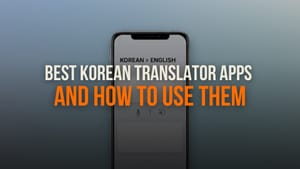Everyone wants to speak Korean these days. Maybe it’s the K-dramas, maybe it’s the music, or maybe it’s that moment when you realize you’ve picked up words like annyeong or saranghae without ever opening a textbook. But turning that curiosity into real speaking ability takes more than memorizing phrases. It’s about knowing how to learn the language, not just what to study.
In this post, we’ll break down exactly how to learn to speak Korean. From mastering Hangul and pronunciation to finding online classes, conversation partners, and immersive tools like Lingopie, you’ll see how each method fits together.
- Korean Aegyo: Korean Words And Gestures To Look And Sound Cute
- 12 Korean Myths And Legends Everyone Learning Korean Should Know
- 15+ Korean Insults That Won’t Get You Slapped (Probably)

How To Speak Korean
Step 1: Learn Hangul (The Korean Alphabet)
Every Korean sentence starts with Hangul. Skip it, and you’ll stay stuck guessing sounds from romanization forever. The good news? Hangul is one of the easiest writing systems to master. It has 14 consonants and 10 vowels, all built from logical sound patterns. King Sejong designed it so that anyone could learn to read and write Korean in a matter of hours—and he meant it.
Spend a day learning the letters, a week practicing them, and you’ll unlock every Korean word you hear. When you can read the symbols, pronunciation becomes predictable. That’s when Korean stops feeling foreign.
Below is a simple breakdown of Hangul’s basic consonants and vowels to help you start recognizing patterns before jumping into speaking practice.
| Consonants | Romanization | Example | English |
|---|---|---|---|
| ㄱ | g/k | 고기 (gogi) | meat |
| ㄴ | n | 나라 (nara) | country |
| ㄷ | d/t | 다리 (dari) | leg |
| ㅁ | m | 물 (mul) | water |
| ㅂ | b/p | 밥 (bap) | rice |
| ㅅ | s | 사람 (saram) | person |
| ㅇ | ng/silent | 아이 (ai) | child |
| ㅈ | j | 자전거 (jajeongeo) | bicycle |
| ㅊ | ch | 친구 (chingu) | friend |
| ㅋ | k | 커피 (keopi) | coffee |
| ㅌ | t | 토끼 (tokki) | rabbit |
| ㅍ | p | 피자 (pija) | pizza |
| ㅎ | h | 하루 (haru) | day |
| Vowels | Romanization | Example | English |
|---|---|---|---|
| ㅏ | a | 사랑 (sarang) | love |
| ㅑ | ya | 약 (yak) | medicine |
| ㅓ | eo | 서울 (seoul) | Seoul |
| ㅕ | yeo | 여자 (yeoja) | woman |
| ㅗ | o | 고양이 (goyangi) | cat |
| ㅛ | yo | 효자 (hyoja) | good son |
| ㅜ | u | 우유 (uyu) | milk |
| ㅠ | yu | 휴지 (hyuji) | tissue |
| ㅡ | eu | 크다 (keuda) | big |
| ㅣ | i | 이름 (ireum) | name |
Step 2: Take a Structured Korean Class
Learning on your own can take you far, but a structured class gives you something self-study rarely does—accountability. A teacher keeps your progress steady, corrects pronunciation before bad habits form, and explains grammar rules that look simple until they aren’t. You’ll get clear milestones, instant feedback, and real-time conversation practice, all of which speed up your ability to speak Korean instead of just recognizing words on a page. Classes also force consistency, which is half the battle when you’re learning a new language.
You don’t need to move to Seoul to join one. Online platforms and language schools now offer beginner to advanced courses taught by native speakers. Some focus on business Korean, others on conversation or test prep, so you can choose what fits your goal. Look for classes that prioritize speaking from the first lesson, not endless grammar drills.
Step 3: Practice Speaking Korean Online
Once you know the basics, the fastest way to sound fluent is to speak out loud. Not in your head. Not silently repeating after YouTube videos. Out loud. The internet makes that easier than ever.
You canalso join Korean language exchanges, find conversation partners, or talk with tutors through sites like HelloTalk, italki, and Tandem. These platforms match you with native speakers who want to learn your language in return, turning practice into real conversation instead of scripted drills. Talking to real people pushes you out of your comfort zone and helps you think in Korean instead of translating every word.
Step 4: Immerse Yourself in Korean Media

Immersion is how you turn knowledge into fluency. You can memorize grammar all day, but unless you hear how Koreans actually talk, you’ll never sound natural. Listening to real voices like those of actors, YouTubers, podcasters can teach rhythm, tone, and emotion in a way no textbook can. The more Korean you hear, the more familiar it becomes.
Best Korean media for immersion:
- K-dramas and movies: Learn natural dialogue, everyday expressions, and polite speech levels.
- K-pop and music videos: Train pronunciation and intonation while memorizing catchy lyrics.
- YouTube and vlogs: Pick up casual slang and modern internet Korean.
- Podcasts and radio: Improve listening speed and comprehension.
- News clips or interviews: Expand formal vocabulary and sentence structure.
This is where Lingopie makes the process easier! Lingopie turns authentic Korean media into interactive lessons. You can watch dramas or shows with Korean and English subtitles, click any line for instant translation, replay scenes, and save new phrases as flashcards.
Step 5: Speak Every Day
You can read, listen, and memorize for months, but until you speak, the language won’t stick. Daily speaking practice forces your brain to recall words fast, form sentences naturally, and build confidence. You don’t need perfect grammar to start. You just need consistency.
Simple ways to speak Korean every day:
- Narrate what you’re doing: “저는 커피를 마셔요” (I’m drinking coffee).
- Repeat short lines from dramas or songs until they sound natural.
- Record voice notes describing your day in Korean.
- Talk to yourself in the mirror for five minutes.
- Join online Korean-speaking communities or language exchange chats.
Learn To Speak Korean With Lingopie
Speaking Korean doesn’t have to feel like homework. You don’t need to live in Seoul or memorize endless grammar tables to sound fluent. What you really need is steady exposure, real conversation, and a bit of daily practice.
If you want to make that process easier, start learning through the shows you already love. Lingopie turns Korean dramas, movies, and series into interactive lessons. You can watch with dual subtitles, click lines for translations, and practice pronunciation by repeating what native speakers say. It’s fun, practical, and addictive in the best way.
Give Lingopie a try now!
FAQ
How long does it take to speak Korean fluently?
With steady immersion and daily practice, most learners can reach conversational fluency in 6 to 12 months. True fluency takes longer, but consistent listening and speaking in real contexts make progress much faster.
Can I learn to speak Korean without a teacher?
Yes. Many learners master Korean using self-study and media immersion. Watching Korean shows, listening to podcasts, and practicing speaking daily can replace formal classes if you stay consistent.
Do I need to live in Korea to become fluent?
No. You can create a full immersion environment at home through online resources. Platforms like Lingopie let you hear native Korean speech daily and learn through context, just as if you lived there.
Is Korean pronunciation hard?
It can seem tricky at first, but once you learn Hangul, the Korean alphabet, pronunciation becomes clear and logical. Each letter has one sound, making reading and speaking much easier than it looks.
What’s the fastest way to start speaking?
Listen and repeat real Korean daily. Focus on mimicking tone, rhythm, and short phrases from native media until speaking feels natural.


![How To Speak Korean: Classes, Apps, And Immersion Tips [2025]](/blog/content/images/size/w1200/2025/10/how-to-speak-korean-2.jpg)


![Spanish Day Of The Dead: Traditions & Vocab Guide [2025]](/blog/content/images/size/w1200/2025/10/spanish-day-of-the-dead-2.jpg)
![Korean Onomatopoeia: 80+ Sounds And Mimetic Words [Guide]](/blog/content/images/size/w300/2025/12/Korean-onomatopoeia.jpg)


![Korean Aegyo: Korean Words And Gestures To Look And Sound Cute [2025]](/blog/content/images/size/w300/2025/10/Korean-agyeo.png)